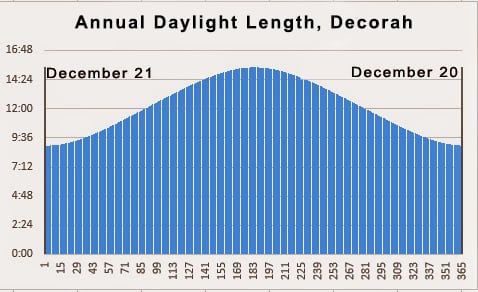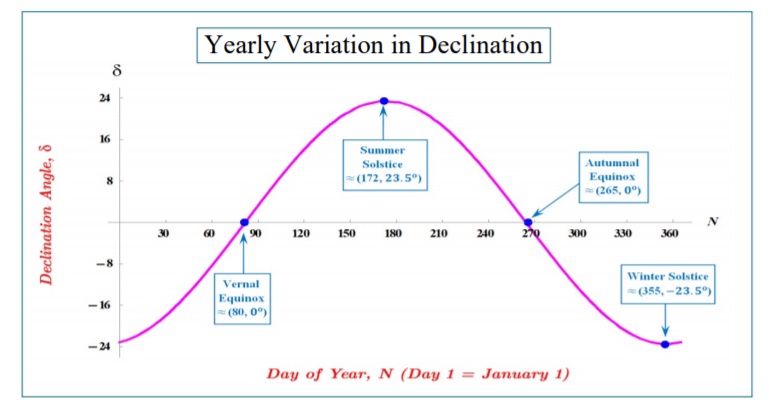Why are eagle couples in Decorah working on their nests and bonding right now? Among non-tropical birds, many activities (reproduction, molt, migration) are linked to daylight length. We’ve primarily discussed the photosensitive period of bird life here, when daylight lengthens, gonads start swelling, and human watchers start counting the days until eggs are laid. However, birds also have a photorefractory period that in many northern birds begins slightly prior to summer solstice in mid-June. Gonads start shrinking, a new hormonal regime takes precedence, and many northern birds start preparing for winter. This might include social behaviors like flocking (something many mid-westerners start seeing in August), the cessation of care for fledglings, serious eating in preparation for migration, and dispersal from home territories. Researchers are quite sure that gonadal changes drive vernal (spring) behavior, but autumnal behavior is a lot harder to figure out.
Daylight length at the 43rd parallel
Since daylight length is so important, we should probably chart it, right? At Decorah’s latitude, the cycle of 365 days plots into a nice bell curve that looks something like this.

Annual Daylight Length, Decorah IA
Of course, there are other ways to plot daylight length. What happens if we plot daylight length by month instead of year? That graph yields a more complex pattern. Some months are rising, some months are falling, and daylight length is approximately equivalent on several days in spring and fall. For example, Decorah enjoyed 10:49 hours of daylight on October 20…very similar to February 20, with 10:44 hours of daylight.

Daylight Length by Month, Decorah IA
Let’s break it down even further. Figures one and two plot daylight length. But what does it look like if we plot the rate of change instead?

Rate of daylight length change through the year, Decorah Iowa
This graph plots how the rate of change changes. While we gain a lot of daylight between February and April, the average rate of change, or slope, is flat at about three minutes per day. Daylight length keeps increasing through June 21, but the average rate of change falls steeply from around three minutes per day to one minute or less, as reflected by the slope of the line. We will see the same thing happen as daylight length diminishes in the second half of the year.
Autumnal bonding and nestorations?
For many birds in northern latitudes, the photosensitive period occurs primarily in cycle one and the photorefractory period occurs primarily in cycle two. So if nestwork is connected to courtship and gonadal swelling, why do our eagles begin nestoration and bonding during the photorefractory period? A couple of thoughts:
- Daylight length decreases rapidly in August, September, and October. In migratory birds, this leads to Zugunruhe, or migratory restlessness. Perhaps the suite of behaviors and hormones that direct migration in some birds initiates gonadal swelling/maturation in bonded territorial eagles.
- Eagles might be physiologically plastic, which would allow them to modulate hormonal timing in response to non-photoperiodic cues. We know that eagle courtship includes gifts of food and nesting materials, side-by-side nestorations, and duetting. These changes might initiate gonadal swelling or prevent full senescence once each year’s breeding period has concluded.
- We know that birds learn, remember, and draw on experience. While our eagles can’t produce long-range weather forecasts, experience and memory might influence nest-building behavior from one year to another.
Bald eagles are complicated individuals who play a long relationship game. The behaviors we watch in late fall and early winter influence hormone production and bonding months down the road. Mates, hormones, and experience all influence the onset of nest-building and courtship, although timing may differ from year to year and eagle couple to eagle couple. We are looking forward to seeing what our eagles do this year!
It’s pretty straightforward to calculate photoperiod for the Decorah eagles, since they don’t migrate and live at a latitude with obvious photoperiod changes. But how about connecting photoperiod to physical changes in the Arctic Tern, a bird that annually migrates from Greenland to Antarctica? Or the Kiwi, a nocturnal bird? How about birds that live in places like American Samoa, which has a shortest day only 1 hour and 41 minutes shorter than its longest day? The more I watch birds, the more questions I have about them.
If you graph the Sun’s position in the sky at the same time of the day during a year at a specific location, it will make a figure-eight shape called an analemma. If you’d like to take a deeper dive into the analemma and how it relates to the graphs above, follow this link: Analemma
Things that helped me learn and write about this topic.
- Astronomical Applications Department of the U.S. Naval Observatory: https://www.usno.navy.mil/USNO/astronomical-applications. Sadly, this site is not fully operational right now. You can also try https://sunrise-sunset.org/ and https://www.weatherspark.com for more information on sunrise/sunset times and daylight length.
- Hormones and migratory birds: https://www.audubon.org/news/researchers-identify-hormone-tells-migratory-birds-stop-eating-and-keep-moving
- Hormones dictate breeding success in birds: https://www.sciencedaily.com/releases/2011/01/110126091502.htm.
- Rate of change and slope of a line. It’s algebra with the Decorah eagles! https://helpingwithmath.com/rate-of-change-slope-of-a-line/.
- Personal communication, late RRP Director Bob Anderson. Thanks for the lesson on photoperiodism!
- Paper: Circannual rhythms in birds, Eberhard Gwinner. Current Opinion in Neurobiology 2003, 13:770–778.
- Paper: Gwinner E, Scheuerlein A: Photoperiodic responsiveness of equatorial and temperate-zone stonechats. Condor 1999, 101:347-359.
- Paper: Dawson A, King VM, Bentley GE, Ball GF: Photoperiodic control of seasonality in birds. J Biol Rhythms 2001, 16:365-380.
- Book: Living on the Wind: Across the Hemisphere With Migratory Birds by Scott Weidensaul. This would make a great present for the bird-lover in your life!
- Book: Sync: How Order Emerges From Chaos In the Universe, Nature, and Daily Life by Steven Strogatz. Another great book, although it isn’t about birds!
The Analemma
Why does the sun form a figure eight instead of a circle if we take a picture of it at the same time and location over a year’s time? Relative to the plane of its orbit, the Earth doesn’t spin with its North Pole pointing straight up. Our axis has a constant tilt, or obliquity, of 23.5 degrees relative to the plane of its orbit. Since the axis remains tilted in the same direction as the earth travels around the sun, there are periods of time where one pole points towards the sun while the other pole points away from it. During the summer solstice, the Sun shines down most directly on the Tropic of Cancer in the northern hemisphere, making an angle of +23.5° with the equatorial plane. During the winter solstice, the sun shines most directly on the Tropic of Capricorn in the southern hemisphere, making an angle of -23.5° with the equatorial plane.

Positive values = longer days for the northern hemisphere!
What does this mean? Decorah goes from 15 hours, 24 minutes of daylight on June 20th (+23.5°) to 8 hours, 58 minutes of daylight on December 21st (-23.5°). On October 20th, Decorah’s angle of declination will stand at -10° 37’ 48 and it will experience 10 hours, 45 minutes of daylight. We measure the sun’s angle of declination on the Y or long axis of the analemma.
The Earth’s orbit around the sun is elliptical or eccentric, which means that our distance to the sun changes throughout the year. The corresponding change in gravitational force causes Earth to move at its fastest in January, when it is closest to the sun, and slowest in July, when it is farthest from the sun. So solar noon, the time of the day when the sun is highest in the sky, doesn’t always occur at the same point in the day, as measured by our watches. A sundial measures solar noon up to 16 minutes ahead or 14 minutes behind a regular clock, depending on the time of the year. On October 20th, Decorah experiences solar noon 15.38 minutes before clock noon. We measure the difference between solar time and clock time on the X or short axis of the analemma.
Look at the analemma below. The declination is plotted on the Y-axis and the difference between mean and solar time is plotted on the X-axis. Why does the bottom lobe appear larger? We are moving at our fastest in January, when we make our closest approach to the sun. The sun appears to move faster and clock time deviates more widely from sun time, making the bottom lobe of the analemma larger. Note how the graph of the equation of time corresponds to the change in the rate of daylight length we plotted earlier in this blog. Our axial tilt and elliptical orbit explains why daylight length change happens more rapidly and unevenly throughout the year. Since eagles don’t have watches, I’ll need to revisit this issue in solar time!

Analemma plotted for Des Moines IA, 2020
Do analemmas on other planets in our solar system look different? They do! https://apod.nasa.gov/apod/ap140516.html
This video nicely illustrates the relationship between our axial tilt, our elliptical orbit, and the analemma. Check it out!
Things that helped me learn more about this topic:
Thanks to Ken Ries for the analemma inspiration!
 The Raptor Resource Project
The Raptor Resource Project The Raptor Resource Project
The Raptor Resource Project